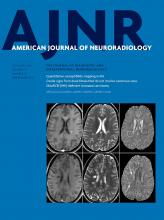We thank Vargas et al for their interest in our work and agree that synthetic MR imaging indeed is a promising technique with many potential applications for both clinical practice and research. As the authors mention, there are similarities between synthetic MR imaging and MR fingerprinting in their potential to reduce scanning time and provide quantitative MR imaging measurements to more objectively characterize tissue properties.1
In terms of clinical applications, SyMRI (SyntheticMR, Linköping, Sweden) has come far in making the sequence available on clinical scanners and integrating the analysis software in the clinical PACS system, making it feasible for clinical practice.2 Further validations of the technique are expected, and recently its quantification of proton-density, T1, and T2 have been shown to be accurate and reproducible, even with different coils.3 These results are promising for multicenter and longitudinal use. A precision study of synthetic MR imaging across scanners and field strengths would, therefore, be especially valuable for future studies and is planned. There are also areas for future developments of the technique, in which FLAIR artifacts are currently being addressed. 3D and further accelerated acquisitions remain on the wish list. In our group, we are currently evaluating nonconventional synthetic contrast weightings, such as phase-sensitive inversion recovery for detecting cortical involvement in multiple sclerosis, and more advanced tissue modeling based on the relaxometry. Other likely future applications include spinal imaging and body imaging, such as musculoskeletal imaging.
Meanwhile, MR fingerprinting is still in the early phases of development with many promising applications. How and where these techniques can be applied and provide clinically important and possibly complementing information remains to be explored. As often found in MR imaging, the main bottleneck in terms of possibilities for both techniques is our imagination.4
- © 2016 by American Journal of Neuroradiology












